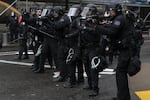Portland police officers had an array of reasons why they thought racial justice protests in 2020 were among the largest and most enduring in the city’s history: pent up energy from COVID-19 lockdowns, weak condemnation of property destruction from political leaders, the district attorney’s decision not to prosecute low level offenses, and restrictions on the use of tear gas.
“It appeared as if many younger people, lacking entertainment and work, often attended the protests, with some gathering regularly to socialize and drink and a portion of those then engaging in criminal activity,” reads an after action report on the summer’s unprecedented demonstrations filed by the Portland Police Bureau.
The bureau’s after action review for civil unrest in Portland between May 29 and Nov. 16, 2020 is compiled in three reports totaling 40 pages. The report, obtained by OPB this week, paints a picture of an agency desperately understaffed and struggling to respond to massive demonstrations for which they were unprepared. But it also reveals an organization out of sync with the community they are charged with protecting, and confused by the depth of anger thousands were expressing toward local officers and policing more broadly.
Not mentioned as potential reasons for the massive protests are a laundry list of grievances against the bureau going back decades, including a well-trodden history of over policing communities of color, excessive use of force against people in mental health crises, the 40 people Portland police officers have killed since 2003 or the zero officers who have been indicted for those killings.
Use of force
The bureau documented more than 6,000 uses of force against protesters through Sept. 30, with squads each reporting six to 12 uses of force per night, according to the after action report. During a typical crowd control event, that would be “at most a couple of uses of force,” the document states.
Officers are required to fill out a report for each use of force. The bureau said that system is not well adapted to the high volume of force incidents and prolonged crowd control situations officers dealt with for months.
The report also blames fatigue among officers and supervisors for the comparatively low quality of the report narratives and the review process.

Portland police fire pepper spray, FN 303 plastic munitions, and aim a 40mm launcher while dispersing protesters on May 30, 2020.
Jonathan Levinson / OPB
Portland’s neglect of these requirements has already run the city afoul of the U.S. Department of Justice. The DOJ has made it clear that documenting and reviewing use of force is a necessary component to using force if the bureau hopes to comply with the Fourth Amendment.
Multiple times since finding the city out of compliance with the settlement agreement, federal prosecutors have shown how Portland officers used force in violation of department directives and that supervisors validated those uses of force with little or no critical assessment. That has a long term impact on the accountability process, the DOJ said.
“The absence of supervisory investigations deprives the accountability system of data needed if allegations of misconduct arise, such as witness interviews,” the Justice Department’s February report stated.
Federal prosecutors said PPB’s justification for some of the force used failed to comport with the Constitution, and that the lack of proper oversight reflected a failure of the city’s accountability structure.
The bureau’s after action report, on the other hand, found that the accountability process was largely functioning as intended.
“During the protests, there were an increased number of complaints filed with the Independent Police Review, a division under the City Auditor’s Office assigned to review police complaints,” the review said. “All of those complaints are being reviewed and processed as appropriate.”
PPB’s report recommends changing the reporting process for crowd control situations and allowing officers more time to complete their write-ups. The report doesn’t explain how allowing more time to elapse between each incident and the report would improve accuracy.
Temporary restraining orders
At the beginning of June, after Portland police had used tear gas and impact munitions for more than a week to disperse largely nonviolent crowds numbering in the thousands, a federal judge issued a temporary restraining order restricting their use.
Prior to the court-ordered limitations, those tools were used as “force multipliers,” helping compensate for being unprepared and understaffed, the after action report states. The bureau’s review goes into detail on all the ways the temporary restraining order impacted officers’ ability to respond to demonstrations.
Among other factors, the review says the restraining order “drastically decreased the options the Bureau had to engage the crowd and disperse them when necessary.”
The police bureau does not mention the indiscriminate use of tear gas and less lethal munitions that led to the lawsuit against the city and ensuing restraining order. Instead, the bureau lauds itself for successfully targeting criminal behavior while protecting constitutionally protected speech.
“PPB quickly distinguished between the peaceful protests and the civil unrest that contained criminal and threatening activity, focusing its efforts to attempt to quell the criminal activity, while also trying to not exacerbate the situation,” the report reads.
That assessment stands in contrast to a federal judge’s findings.
“There is no dispute that Plaintiffs engaged only in peaceful and non-destructive protest,” Federal District Judge Marco Hernandez wrote in his June 9 ruling. “There is no record of criminal activity on the part of Plaintiffs. To the contrary, there is even evidence that some protesters were confronted with tear gas while trying to follow police orders and leave the demonstrations.”

Mayor Ted Wheeler, Police Chief Chuck Lovell and District Attorney Mike Schmidt speak at a press conference Aug. 30, 2020.
Bradley W. Parks / OPB
The Portland Police Bureau’s report doesn’t discuss applications of force in violation of the Fourth Amendment or how to prevent such violations in the future. In one instance cited by Hernandez, he found that Officer Brent Taylor fired less lethal munitions at a protester who wasn’t acting aggressively.
“Officer Taylor testified that he deployed his FN303 [less lethal rifle] against an individual holding onto a banner because he believed the banner would later be used as a weapon,” Hernandez wrote. “But none of the circumstances cited by Officer Taylor suggested that this banner was a weapon or would be imminently used by protestors as a weapon. Police officers had ample opportunity to observe the banner before Officer Taylor deployed his munitions.”
Less than a month after the restraining order restricting the use of tear gas and impact munitions, another federal judge slapped the city with a restraining order restricting officers’ interactions with journalists and legal observers. Up to that point, officers had free rein to force media and legal observers to disperse along with protesters, potentially leaving no witnesses to the thousands of force incidents logged by the bureau.
The ruling prompted dozens of live streamers to label themselves press, complicating crowd dispersals, according to the after action report.
“The results were officers bypassing individuals marked as ‘press’ who would then assault the officers from the rear, as the officers pushed the crowd from the area after declaration of an unlawful assembly,” the report states.
Portland police’s report does not mention the numerous instances where members of the media were pushed, shoved, or arrested while documenting protests.
Understaffed and unprepared
Over the course of weeks and months of protest response, the report shows how the bureau struggled to adapt an already lean organization to the dramatically increased demands on personnel at all levels.
For 15 days after protests began May 29, the bureau cancelled all days off and had all available officers working protest duty, a situation which ultimately became unsafe, according to Portland police.

Police Chief Chuck Lovell at a press conference Aug. 30, 2020.
Bradley W. Parks / OPB
“Even though the situation had not changed and was as perilous as ever, the increasing odds that an officer might make an error due to fatigue became untenable,” the report says. “The Bureau was running up against the physical constraints of what humans can do and the Bureau could not continue the tempo without facing error(s) and thus, began to slowly give officers their days off again.”
Detectives assigned to process arrests at protests were unable to maintain their current caseload. One solution was to use newly hired officers who had not been able to attend the police academy due to COVID to review evidence.
Antiquated technology also proved to be a significant impediment to managing the massive amount of reports and paperwork generated during the months of protest response. The bureau is the only one in the city that does not use Microsoft Office 365, a platform it says it desperately needs in order to remedy a number of deficiencies exposed by the protests.
A lack of undercover officers, too few officers trained in incident command, not enough members of the rapid response team, and being unprepared to manage demonstrators who questioned the fundamental legitimacy of the police were all challenges the bureau found in its review.
The federal law enforcement response, which escalated dramatically in July and reinvigorated a dwindling protest movement, helped PPB in at least one way, according to the report. Officers struggling to protect their eyes from powerful green lasers had started using goggles that offered some protection, but made it difficult to see at night. The presence of federal officers provided a solution.
“To our fortune,” the report states, “the nightly protests shifted to the Federal Courthouse and most of the lasers were directed at federal officers and not our own members.”
